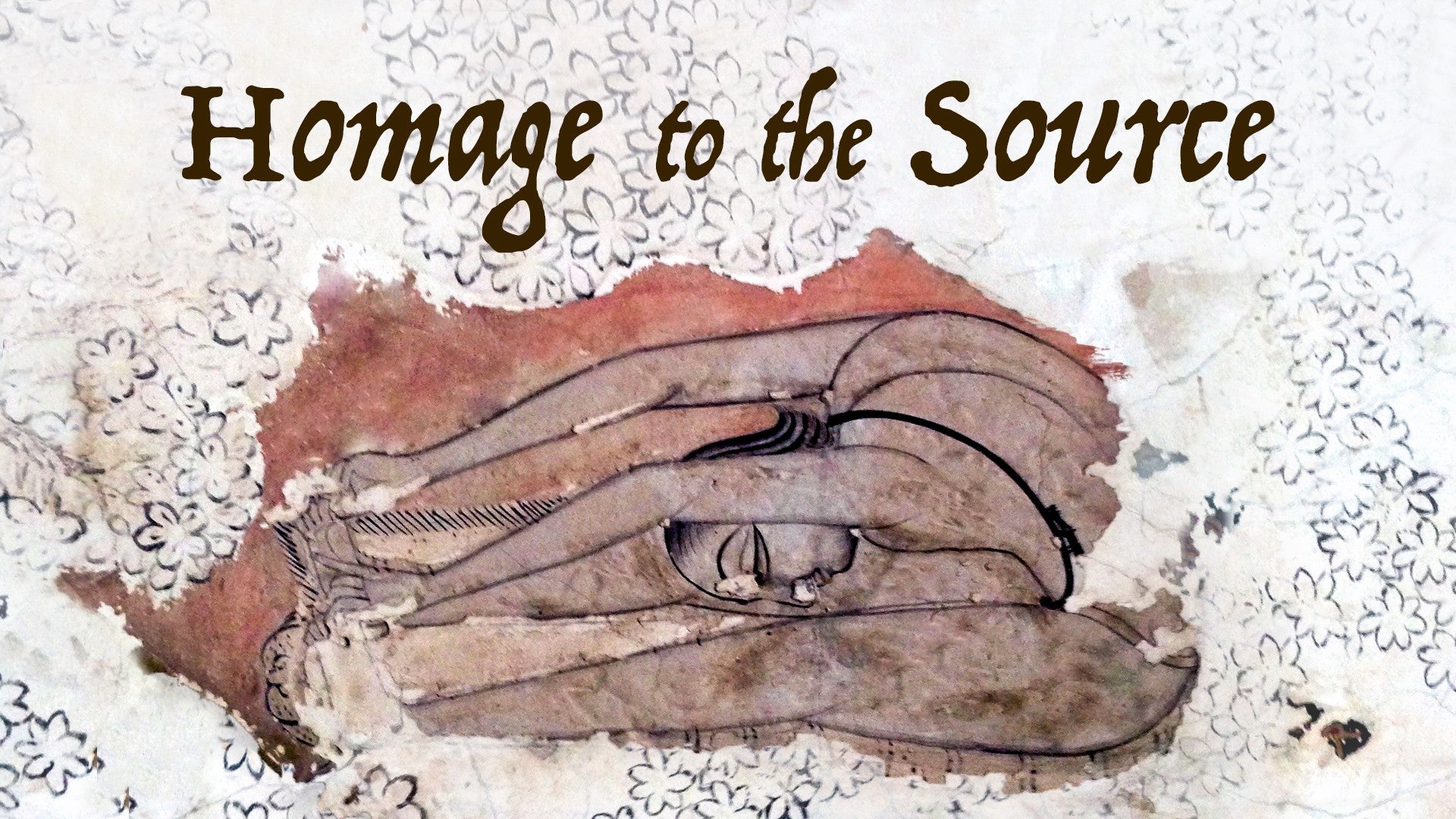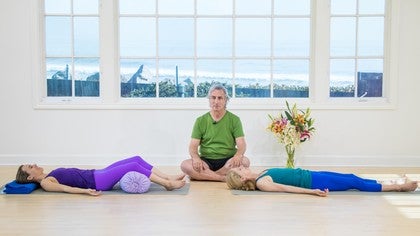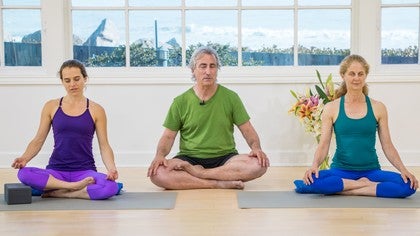Description
Perhaps the most well known modern yoga pose, Richard guides us into this posture with precise and detailed instruction. Together we find balance, stillness, and presence.
About This Video
Transcript
Read Full Transcript
Hi we're here with Ilana and Betsy for Shavasana. Shava is a Sanskrit word that means corpse literally. The pose is also sometimes called mritasana and R not really an R I T A spelled usually which means the death pose. Unfortunate name in the West anyway. We may get into that a little bit later. However right now we're gonna just do the the instructions to get into the posture. So if you both could put your feet on the floor in front of your pelvis please bend your knees and I'd like you to keep your knees bent both and lean back onto your forearms. Keep your upper torso and head off the floor and in this position if you would both lift up on your tailbone a little bit away from the floor and curl it out towards your heels yes and then lay the pelvis back down on the floor very good now start to roll the spine down lightly on the floor head comes down last very nicely done good and as you can see we have a blanket set up for Ilana's head very often a big more beginning student a little bit tighter student the head doesn't rest comfortably and evenly on the floor and it really needs a little bit of support and that's what we've done for her. Now the arms can lay off to the sides palms turned up as always and again it's preferable to have the index knuckles resting on the floor if that's not possible then the middle knuckles will do fine but in any case you want the same knuckle on both hands to rest on the floor and then as far as the legs please just stretch one leg out at a time as we've been doing hold it a little bit of above the floor inhale press through the heel and turn and then press the leg down and let it go completely roll out uh-huh and feet heels not wider than the hips very good and let the legs go now we have a bolster for Ilana so if you want to bend your knees again please exhale and we'll slide the bolster on it this is very useful for more less experienced students what it does is it helps the heads of the thigh bones to drop back in the pelvis soften the groins which allows the breath to move more deeply into the torso now we have to make sure that we're lying very evenly on the floor as we did earlier in the breathing exercise heels resting evenly on the floor buttocks scapulas backs the hands as I mentioned the head in the neutral position ears equidistant from the ears eyes equidistant from the floor tongue and eyes relax tongue on the floor of the mouth eyes dropping back in the sockets again toward the back of the head and finally at least but last but not least the brain which mr. Iyengar would as said about is the hardest organ of all to adjust it wants to shrink a little bit get a little bit smaller inside the skull case and then drop to the back of the skull onto the occiput now Shavasana can be performed anywhere from maybe a few minutes to up to 15 or 20 minutes actually if you have enough time to do that my training tells me to do five minutes of Shavasana for every half an hour of practice so for example if you practice for a half an hour you would do a five minute Shavasana an hour would be a ten minute pose and there's three things that are very important to do about Shavasana the first one of course being to be very neutral on the floor any imbalance in the body any any imbalance is experienced by the brain whether you not whether you whether you feel it consciously or not the brain will feel it and that will create a disturbance in the brain the other thing is to be very very quiet now in most Asanas and all the other Asanas in fact it's okay to move around and wiggle about a bit but Shavasana is unique in the in the fact that it requires you to be very very still so it's good to before you get ready to go into the pose completely do all the fidgeting you need do all the scratching you need and then make up your mind to be still for the next few minutes or however long you're practicing for and then finally the last thing that's important for Shavasana is what I call presence P R E S E N C E presence which means there's a very strong tendency for especially for beginning students to wander off and lose the threat of being present in the room in the body so it's very important to stay here and you want to focus on something that's happening in the present such as your breath or your the feeling of the back of your body on the floor something that anchors your awareness in the present moment and it's good to have a timer available to make sure that you stay in the pose a particular time you can use a timer if you're if you're short on time but ideally for Shavasana what you want to do is stay in the pose for as long as you feel is needed now most people I think in modern yoga tend to diminish the importance of Shavasana but I think it's a very very important pose and I think it should be done with a lot of attention and a lot and spend some time in the posture at the end of your practice or anytime during the day that you if you really need time to relax when you're ready to come out of Shavasana again we talked about this earlier it's very important to do it very methodically I see a lot of beginning students just sort of pop up out of the pose and that's really sort of counterproductive it disturbs the brain and it sort of undoes all the good work you've done in the pose itself so again the start what you want to do is begin to just wiggle the fingers and toes just a little bit when you lie still for a long a length of time you're you're the feeling of being a contained in a physical body begins to dissolve a bit and you want to start to bring yourself back into that feeling of being contained you start with your fingers and toes and just wiggle around a little bit and then very gradually you can start to increase the stretch in the hands and feet and then work that up along the limbs through the arms and legs into the torso and into the neck now remember that when you start to open your eyes initially you just want to open them just a little bit so the room falls into your eyes and you don't want to reach out with your vision and grab onto the room and then eventually you can start to stretch you've all seen what cats and dogs do when they come out of a nap they think a big long stretch and that's something that you can do at some point after you after you've started the exit so you can stretch as much as you like very good and then again it's very important to take an exhalation and with a minimum amount of effort roll over to your usually teachers ask you to roll to the right side which would they want you to roll away from the side of the heart which is on the left side although I've had some teachers in the past asked me to roll first to the right and then to the left you can try both ways to see if one suits you more than the other but in any case when you come up you want to use the strength of your arms to push your torso away from the floor and again the head slowly comes up drags up after the head off the torso and then you can come and sit and it's always good to sit for a little while and just let yourself get accustomed to being back in the in the real world more or less and this is Shavasana the corpse pose thank you






You need to be a subscriber to post a comment.
Please Log In or Create an Account to start your free trial.